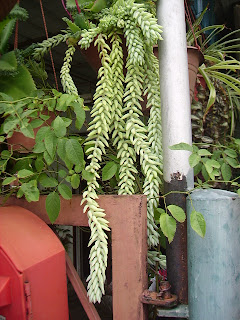I'm pretty sure this is one of the plants that hates you when it comes to touching. It punish you as it snaps its succulent leaf from the main branch. And before you know it - all is left is a twig which slowly dries up and that is the end of this donkey's tail plant.
I read few website profiles on these and all they give you is simple basic information that you can certainly go wrong and a high chance of killing it. (killing me softly) The word hardy is a mis-interpretation.
Many of my garden friends had tough time handling this one & in most cases they just "drop off" and die.
So what is the trick here? How to keep them successful?
These are my tips:
1) When first purchased from the nursery - check the soil.
If the soil medium contains coconut husk or the medium is mushy - change the soil mix.
I would suggest use more sand (2/3 portion) and black soil mix (1/3 portion)
The most important thing you must handle is that it must have a good drainage soil.
(water which gets stagnant in the pot tend create root rot - often its too late to detect as the plant is holding on until the rot is visible)
2) Hang/Place the plant where there is less or no movement and doesn't get knocked down.
Any slight accident can lose/drop the existing succulent leaves.
And I propose the best one:
KEEP OUT OF REACH OF CHILDREN
(My friend's plant died when his 7-year old daughter joyfully snapped all the leaves)
3) Watering - water it sparingly until the plant establish itself.
My best tip is plant another hardy succulent plant together that takes up most of the moisture and water out of the plant (Mother of Thousand) as it would recreate a tight fitted area for the roots to hold on the soil.
4) Once the plant establishes - Do not repot.
Just leave it as it is. I had made a mistake of repotting and found the most of the fronds didn't survive and I have to start all over again with a small stubble.
5) Propagation.
So if you need to propagate - trim off from the long existing fronds.
Cut it about 3-4 inches long - remove half of the leaf succulents and leave it to dry for a day or two.
(The wound needs to dry up before placing it into the soil - planting it too soon can cause branch rot
and you might just loose that piece of frond)
- Again : Water sparingly.
It would be good to water it only when the soil had totally dries up.
If you find the soil is wet - then don't water.
6) This plant is very slow to grow - but once it starts growing.
Its really a beauty to behold.
7) WARNING - Same name for 2 different plants.
"Donkey tail" is a common name given to 2 very different plants.
The one in the picture is known as Sedum Morganianum - its a succulent (just like Mother of Thousand & Aloe Vera)
The other is Euphobia myrsinites - this one is poisonous.
Infact most Euphobia species are poisonous. So do get to know your plant before you purchase them.
I was very much thinking of having this plant in my garden when I noticed this particular one planted on a hanging pot. It has a pendant-like rossette which is quite beautiful.
After reading the detail and the testimonies of all the gardeners who suffered dearly with burns and near blindness (I definitely skipping having this poisonous plant)
Read more about the poisonous plant (Euphobia myrsinites)
click below for identification & more information:
http://davesgarden.com/guides/pf/go/781/
Let me know your experience and thoughts about this plant in your garden.

























































